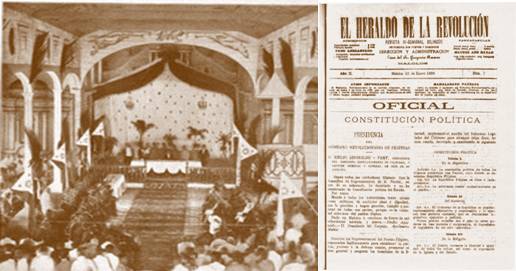The History of the Philippines and its Constitutions during the American Colonization Era
History of the American Era Constitutions
Because
of its long history as a trading hub in Asia, the Philippines were colonized
first by the Spanish and then by the Americans. The majority of the people was
converted to Catholicism by the Spanish, and the religion still holds sway in
the nation. Nationalist sentiment started to spread among groups of Indios (the
Spanish term for the Filipinos) in the latter part of the more than 300-year
span of Spanish rule. This was largely fueled by the writings of national hero
Jose Rizal (who was later put to death by the Spanish government) and other
Ilustrados (the Filipino intelligences). On June 12, 1898, a revolt against
Spain began, and the insurgents proclaimed the independence of the Philippines
at Kawit, Cavite.
 |
| Katipunan's war against the Spaniards |
After the 3-century long suffering under the Spanish rule came
to an end, the First Philippine Republic created and approved the Malolos
Constitution, the first Philippine constitution and the first republican
constitution in Asia in 1899.
At
long last we are finally free, or so we thought. During the Spanish-American
War of 1898 the revolutionaries supported the Americans in the war in hopes
that the United States would grant the Philippines independence once it had
defeated Spain. However, this did not take place. Following Spain's transfer of
the islands to the US in the Treaty of Paris, the US started ruthlessly
repressing the Philippine independence movement.
The
United States Congress established Organic Acts for the management of the
Philippine Islands' government. The first one established a Philippine Assembly
made up of Filipino individuals in the Philippine Organic Act of 1902. The
second was the Philippine Autonomy Act of 1916, also known as the Jones Act,
which stated that independence would only be given following the development of
a stable democratic government based on the American model and not the French
model, as the previous constitution had done.
In 1934, the Tydings-McDuffie Act, often known as the
Philippine Independence Act, was approved by the US Congress. It is a law
passed by the Congress that specified the steps needed for the Philippines, a
colony of the United States at the time, to gain independence following a
ten-year transition period.
.jpg) |
| President Manuel L. Quezon of the Commonwealth Government in 1935 |
It was intended that once the Philippines gained
independence on July 4, 1946, it would continue to serve as the country's legal
framework. However, that plan was derailed by World War II and the Japanese
invasion on December 8, 1941.
Following the liberation of Bataan and Corregidor in 1942, when the gallant Filipino fight against insurmountable odds was ultimately put to an end, the
American period has passed.




_and_ten_of_the_delegates_to_the_first_Assembly_of_Representatives_that_passed_the_Con_-_NARA_-_530993.tif.jpg)
Comments
Post a Comment